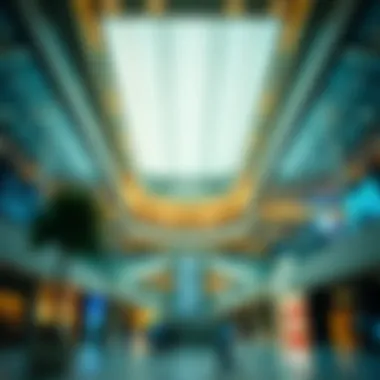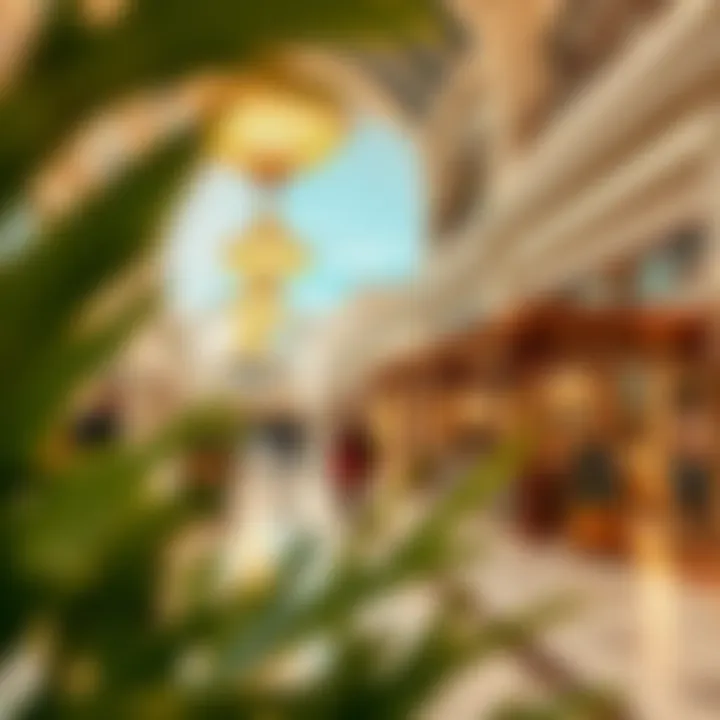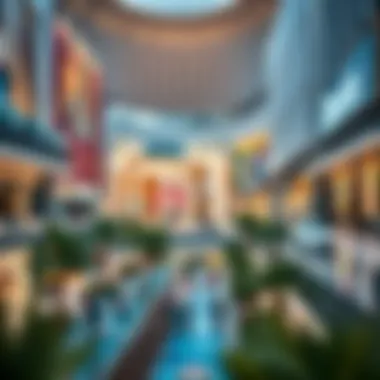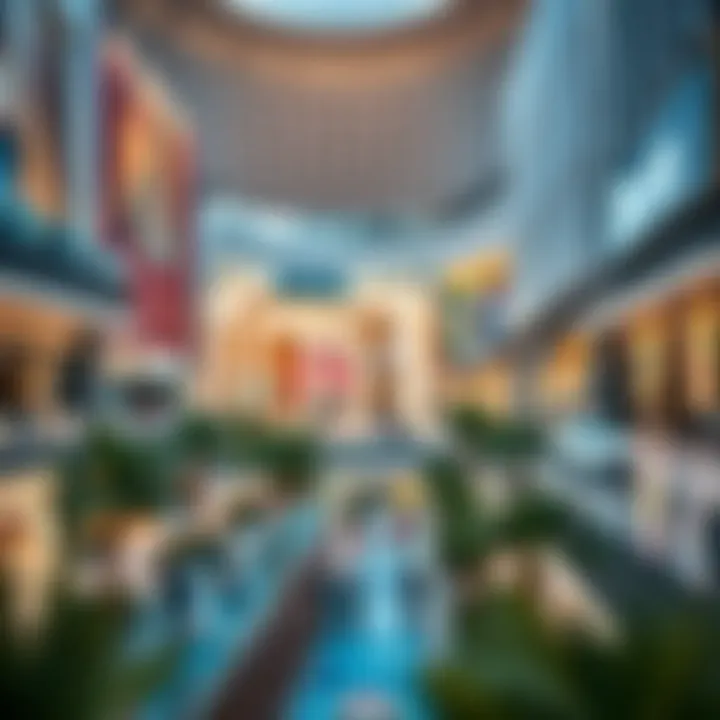Exploring the Mall of Dubai: Key Insights and Trends


Intro
The Mall of Dubai stands as a striking visual representation of architectural grandeur and retail wonder. Nestled in the heart of one of the world’s most vibrant cities, it is more than just a shopping destination; it embodies the very essence of Dubai’s dynamic commercial landscape. From its awe-inspiring structure, which seems to touch the sky, to the endless array of shops, restaurants, and entertainment options, the mall has become a microcosm of Dubai's thriving economy.
In this exploration, we will peel back the layers of the Mall of Dubai to uncover not only its architectural brilliance but also its role as a cultural hub and an economic powerhouse. With insights tailored for property enthusiasts, investors, and those intrigued by real estate trends, we will discuss the currents of the market, the opportunities for investment, and the broader implications for Dubai's growth.
Whether you're a broker seeking to understand the local market or an expatriate keen on investing, this guide will offer a comprehensive overview of what makes the Mall of Dubai pivotal to the local economy. Let's embark on this journey together to see how this iconic landmark shapes the landscape of retail, culture, and investment.
Prelims to Mall of Dubai
The Mall of Dubai stands as a beacon of retail and leisure, attracting millions from around the globe. Nestled in the heart of the city, this mall isn't just a shopping destination; it's a cultural hub, drawing together the vibrancy of Dubai's diverse community and its ever-growing tourism industry. To fully grasp the essence of this massive structure, one must consider its historical context, architectural significance, and the innovative spirit that underpins it all.
With an area sprawling over 1.1 million square meters, the mall marries modern design with traditional influences, embodying a unique blend that reflects Dubai's evolution. It serves not only as a marketplace but also as a place where individuals immerse themselves in entertainment, fine dining, and cultural experiences. This rich tapestry of offerings positions the Mall of Dubai as a linchpin in the city's esteemed social and economic ecosystem.
Understanding the inception and growth of such an iconic landmark is crucial for stakeholders. Investors, in particular, need to be aware of the various elements that contribute to the mall's thriving status. Comparatively, expatriates can benefit from the leisure and cultural experiences available, while buyers and researchers might explore the underlying factors that drive consumer behavior and economic trends within this vibrant locale.
Retail Landscape of Mall of Dubai
The retail landscape of the Mall of Dubai stands as a beacon for consumers, investors, and regional trends in the retail sector. With its grandiose scale and an array of offerings, the mall plays a vital role in shaping shopping habits and economic activities. Understanding its retail dynamics helps to appreciate the pivotal influence it has on both local and international markets. This chapter looks at the tapestry of retail offerings, shopping trends, and consumer behaviors that uniquely define this bustling hub.
Diverse Retail Offerings
Luxury Brands
Luxury brands in the Mall of Dubai offer an experience that goes beyond mere shopping; they create a lifestyle. High-end stores such as Gucci, Chanel, and Louis Vuitton not only showcase products but also embody aspirational living and exclusivity. The presence of these brands signifies that the mall is not just a shopping destination, but a cultural touchstone for luxury enthusiasts. The allure of luxury brands lies in their quality, heritage, and craft, just to name a few key traits. As discerning consumers step into these plush boutiques, they expect impeccable service and aesthetic environments. Yet, high prices can deter some would-be buyers, making luxury an elite experience.
Local Artisans
While the luxury brands draw significant foot traffic, local artisans bring a unique flair to the mall. Their products offer stories, cultural connections, and authenticity that often resonate more deeply with shoppers looking for something special. From handcrafted pottery to locally sourced textiles, these artisans enrich the mall's landscape with flavors of UAE's heritage. Showcasing local talent fosters community spirit and encourages sustainable practices in craftsmanship. However, the challenge remains: Can these artisans compete with mass-produced items in terms of visibility and scale?
Dining Experiences
Dining experiences in the Mall of Dubai take gastronomy to another level. This section features an eclectic mix of global cuisines—from high-end gourmet dining to quick bites that cater to every palate. Restaurants like Zuma or Nobu offer a fine dining experience that attracts both tourists and locals, while food courts provide familiar and affordable options. The unique characteristic of dining in the mall is that it complements the shopping experience seamlessly, allowing visitors to recharge before hitting the stores again. However, the myriad of choices can overwhelm visitors, potentially leading to decision fatigue.
Shopping Trends
Consumer Behavior
Understanding consumer behavior is crucial for anyone engaging with the Mall of Dubai. With shopping becoming an experience rather than an errand, shoppers are keen on immersive environments that engage multiple senses. Influenced by social media and marketing strategies, consumers often seek out unique items that can be showcased online. Brands inside the mall that create exclusive collections or pop-up events can capture attention and drive sales, yet this also places pressure on traditional retailers to adapt quickly to changing trends.
Sustainable Practices
Sustainable practices are increasingly becoming a hallmark of modern retail within the Mall of Dubai. Many brands, both local and international, are adopting eco-friendly measures, from reducing plastic usage to ethical sourcing of materials. This is a growing trend that attracts environmentally conscious consumers, thus expanding the market segment that retailers cater to. Establishing sustainability as a core aspect of a brand not only enhances its reputation but can also positively impact the bottom line. The challenge here lies in ensuring that green practices don’t inflate costs to the point where they alienate a broader customer base.
Online vs In-store Shopping
In an age where e-commerce has taken off, the comparison between online vs in-store shopping is ever-relevant. The Mall of Dubai offers an experience that online shopping can’t replicate—a tangible connection to products and the social interaction of fellow shoppers. However, the convenience of online platforms continually poses a threat. This has prompted many stores to enhance their digital presences through apps and online availability, aiming to provide the best of both worlds. The unique feature of blending the physical store environment with digital enhancements may lead to a richer shopping experience, but the question remains: can they keep this balance without overwhelming shoppers?
By understanding these nuances of the retail landscape, investors and shoppers alike can better navigate the complexities of today’s consumer-driven market.


Cultural and Entertainment Aspects
The Mall of Dubai serves as a pivotal hub not just for shopping, but also for cultural and recreational activities. This multifaceted nature enhances its appeal to a diverse audience and plays a crucial role in fostering a vibrant community atmosphere. Engaging with cultural events and entertainment facilities promotes social interactions and elevates the overall experience for both residents and visitors.
Cultural Events and Festivals
Cultural events in the Mall of Dubai are vibrant and varied, offering something for everyone. Often, these gatherings align with significant local or international festivities, thereby enhancing the community spirit.
Seasonal Festivals
Seasonal festivals highlight the rich tapestry of culture within the Mall. These events celebrate occasions such as Eid, Diwali, and Christmas. Each seasonal festival features unique decorations, festive ambiance, and thematic activities that draw crowds. Visitors enjoy workshops, performances, and traditional cuisines provided by local vendors. The key characteristic of these festivals lies in their ability to create an inclusive environment where diverse cultures coalesce. This results in a truly engaging experience, making the festival a highly beneficial attraction for families and tourists alike, tempting them to explore more of what the mall offers.
However, organizing such events can be resource-intensive, and potential weather-related disruptions can pose challenges.
Art Exhibitions
The art exhibitions within the mall introduce visitors to the local art scene and global artistic perspectives. These exhibitions often feature works from both established and emerging artists, blurring the lines between commercial and creative spaces. A key aspect of these exhibitions is their interactive nature, allowing guests to engage with the art and artists through commentaries or guided tours. This creates an atmosphere of appreciation and dialogue, enriching the cultural fabric of the mall. This angle makes them particularly appealing, attracting art enthusiasts who might not typically think of a mall as a cultural venue.
The unique feature lies in the integration of contemporary art with the mall's commercial space. However, maintaining high standards for the exhibitions could be challenging given the influx of different styles and visions.
Musical Performances
Musical performances add a dynamic layer to the mall experience, featuring various genres from classical orchestras to modern bands. These performances often occur during major events, offering free concerts that encourage foot traffic and elevate the social experience. The key characteristic is their accessibility: anyone can wander by and enjoy live music without the formality of tickets or reservations. This casual yet engaging ambiance often fosters enjoyment and gives artists exposure, creating a win-win scenario. But, these performances may not always cater to every individual's taste, leading to mixed reactions from the audience.
Entertainment Facilities
The entertainment facilities within the Mall of Dubai exemplify the focus on family-friendly entertainment while also catering to various age groups.
Cinemas
Cinemas within the mall provide a premium viewing experience that includes advanced screening technology and varied film options. They often host premieres and movie events, creating buzz and excitement. The unique feature of these cinemas is the luxury seating and gourmet refreshment offerings that go beyond typical concessions. This enhances the experience, making it more than just watching a film but an immersive outing. However, ticket prices can be on the higher side, which might deter some budget-conscious visitors.
Family Entertainment Centers
Family entertainment centers cater to children and families, offering arcade games, bowling, and virtual reality experiences. These facilities emphasize providing a safe and fun environment for younger audiences, which is crucial for attracting family visits. A distinctive aspect is their ability to host birthday parties and group gatherings, making them popular for special occasions. Yet, competition from standalone entertainment venues may pose a challenge in maintaining their appeal within a shopping environment.
Art Installations
Art installations around the mall create a visually stimulating environment that encourages exploration. These installations are often interactive or thematic, creating a dialogue between the space and the visitors. A critical characteristic is their temporary nature, allowing for constant refreshment of the visual narrative within the mall. This changing canvas can tantalize return visitors and encourage them to share their experiences on social media, enhancing the mall’s visibility. However, logistical challenges in installation and maintenance can sometimes limit the scale or duration of these exhibits.
Each of these aspects contributes to the overall cultural depth and entertainment value of the Mall of Dubai, making it a standout destination beyond just retail.
Economic Impact of the Mall
The Mall of Dubai stands as a massive symbol of luxury and sophistication, not just for shoppers but also as a powerhouse for economic growth. Understanding its economic impact is paramount for several reasons. Primarily, it illustrates how retail hubs can influence the local economy, creating jobs, drawing tourists, and nurturing the growth of small businesses. The ramifications of this can be observed in various sectors, from hospitality to real estate, resulting in a vibrant economic environment that encourages investment and development.
Job Creation
The Mall of Dubai is an economic engine, contributing significantly to job creation. With its vast expanse of retail space, restaurants, and entertainment facilities, it employs thousands of individuals, ranging from high-end retail workers to hospitality staff. The ripple effect of such employment extends beyond just the mall itself—there's a growing need for support services such as cleaning, maintenance, and security. Moreover, the employment opportunities created here often promote skill development, enabling individuals to build lasting careers.


- Direct Employment: The mall itself provides both full-time and part-time positions.
- Indirect Employment: Surrounding businesses, such as public transport services and nearby restaurants, see increased hiring due to heightened foot traffic.
These jobs not only help in sustaining local economies but also contribute to the overall improvement in living standards. When people have a stable income, they spend more, thereby stimulating further economic activity throughout the region.
Tourism Influence
Tourism is a significant contributor to Dubai's economy, and the Mall of Dubai plays a pivotal role in this sphere. With millions of tourists flocking to the city every year, the mall becomes a central point of attraction not just for shopping but for an entire range of cultural and entertainment experiences it offers. It serves as a magnet for international visitors looking to partake in a uniquely Dubai experience.
- Increased Footfall: The mall attracts visitors from various parts of the world, enhancing the local tourism sector.
- Cultural Exchange: From art exhibitions to seasonal festivals, such activities create a platform for cultural exchange, enriching the local community.
- Economic Multiplier Effect: Money spent in the mall trickles down into other parts of the economy, from hotels to local transport services, creating a comprehensive ecosystem of economic benefits.
"The Mall of Dubai is not just a shopping destination, but a cultural hub, significantly contributing to the tourism landscape in the UAE."
Local Business Growth
Finally, the Mall of Dubai contributes to the growth of local businesses. By featuring local artisans and brands alongside global giants, it creates an invaluable platform for these smaller enterprises to thrive. This not only showcases local talent but also drives innovation and diversification within the retail landscape.
- Partnerships with Local Brands: The mall often collaborates with local shops, providing them the exposure they may not secure on their own.
- Boost to Entrepreneurship: The success stories emerging from the mall inspire a new wave of entrepreneurs who see the potential for growth in the local market.
- Enhancing Community Identity: The presence of local businesses enhances the identity of the mall, making it a unique stop that reflects the cultural tapestry of Dubai.
Investment Potential
Investment in the Mall of Dubai is not merely about financial gains; it encapsulates an intricate relationship between real estate, consumer behavior, and broader economic currents in Dubai. This multifaceted topic encompasses various components such as commercial and residential opportunities which together, create a robust ecosystem for potential investors. Understanding these dynamics can significantly influence decision-making for stakeholders, including investors, brokers, expatriates, and buyers.
Real Estate Opportunities
Commercial Spaces
When it comes to commercial spaces, the Mall of Dubai is akin to a magnet for entrepreneurs. The diversity of businesses found here isn’t just a testament to its retail success but serves a larger narrative about commercial opportunities in the region. With over a thousand stores ranging from high-end luxury boutiques to more accessible retail chains, the mall attracts both tourists and local customers alike, making it a ripe choice for anyone looking to invest in commercial real estate.
The key characteristic of these commercial spaces is their strategic location and high foot traffic, which greatly enhances visibility and customer reach. These locations have been demonstrated to yield substantial returns on investment, given the mall's continuous growth and popularity.
One notable unique feature of these commercial establishments is the integration of both local and international brands, providing a balanced mix that appeals to a variety of consumers. The advantages here are clear: investors can benefit from a diverse clientele, safeguarding their interests even during economic downturns. However, managing a commercial space in a competitive environment can pose challenges, as the market is always changing and evolving.
Residential Properties
Turning our attention to residential properties, the charm of living near the Mall cannot be overstated. This area is transforming into a vibrant community, merging the best of urban living with convenient access to retail spaces. The allure of luxury apartments and modern townhouses nearby offers ideal living situations for expatriates and locals alike.
The key characteristic of these residential offerings is their proximity to major shopping hubs, dining, and recreational facilities, making them exceptionally attractive for young professionals and families. With amenities often included such as swimming pools, gyms, and social areas, they stand out as a top choice for quality living.
However, it’s important to note the unique feature of residential properties in this vicinity—they tend to be on the higher end of the market range. While this suggests an appreciation in value, it may pose affordability issues for some. Potential buyers should assess their financial capabilities thoroughly when considering these opportunities.
Market Analysis
Future Growth Projections
Looking ahead, the future growth projections for the Mall of Dubai paint an optimistic picture. Analysts are buzzing about the mall's continued expansion and adaptation to market trends. Understanding these projections is crucial for any investor. The mall's strategic initiatives are not just enhancing its current offerings; they aim to ensure sustainable growth which can create a steady stream of revenue.
This aspect is particularly beneficial as it highlights the potential for increased property values over time. Collaborations with tech firms to introduce innovative retail solutions are set to boost shopping experiences, thereby attracting even larger crowds. The advantage here lies in the comprehensive data trends that indicate a growing interest in both retail and residential markets surrounding the Mall.
Risk Assessment


No investment comes without its risks and understanding those is essential for any potential investor. The risk assessment surrounding the Mall of Dubai involves analyzing various factors such as economic shifts, global market fluctuations, and even regional tourism trends. Acknowledging these risks provides a clearer picture of the landscape for informed decision-making.
One key characteristic of the risk assessment process is the need for investors to remain vigilant. An unexpected downturn in tourism or economic instability can impact revenues realized from both commercial and residential properties. Here, accurate market insights can pose advantages, giving investors a solid grounding on which to base their strategies. Keeping abreast of local and global events will be vital for navigating these waters.
Future Developments
Future developments at the Mall of Dubai present a fascinating glimpse into the strategies employed to enhance this iconic structure's footprint in the region's real estate and economic landscape. As this shopping giant continues to evolve, the focus on expansions and sustainability initiatives becomes paramount. Understanding these elements not only highlights the mall's potential growth trajectory but also its responsiveness to contemporary challenges.
Planned Expansions
The mall is gearing up for a series of planned expansions aiming to accommodate the increasing demand from both locals and tourists. One can say that these expansions are not just bricks and mortar additions but are rather a thoughtful integration of spaces that cater to diverse needs. More dining venues, additional entertainment facilities, and retail outlets designed to attract an array of demographics contribute to the mall's ongoing appeal.
- Experience Zones: One of the striking features of the planned expansions involves the introduction of specialized zones. For instance, there’s talk of areas dedicated to virtual reality gaming and e-sports, catering to the younger crowd possibly while enhancing footfall.
- Mixed-Use Developments: Additionally, merging commercial and residential spaces can provide a community feel, making the mall a social hub rather than simply a shopping venue.
These developments are critical as they not only keep pace with the rapidly changing consumer preferences but also promote longer visits, thereby increasing potential revenue streams.
Sustainability Initiatives
In today’s climate-conscious world, sustainability initiatives can't be overlooked. The Mall of Dubai recognizes this and aims to embed sustainable practices into its future framework.
Green Building Practices
The foundation of the mall's approach to sustainability lies in its commitment to green building practices. This isn't just a trendy label; it reflects a genuine commitment to reducing the environmental impact associated with large-scale constructions.
Key characteristics of these practices include:
- Energy Efficiency: The implementation of energy-efficient systems lowers operational costs and promotes an eco-friendly image.
- Water Conservation: Programs focusing on recycling water for landscaping and other uses reduce dependency on local water resources.
A unique feature of these green practices is their ability to attract environmentally aware consumers. In an era where consumers favor brands with a conscience, this practice is becoming increasingly advantageous, establishing the mall as a leader in sustainable retail. However, such initiatives do come with challenges, including higher initial costs and potential for slower returns on investment.
Waste Management Solutions
Moving onto waste management solutions, the Mall of Dubai aims to tackle one of the significant challenges that large establishments face. Effective waste management is not only about proper disposal but also about minimizing waste generation at sources.
The mall’s approach includes:
- Recycling Programs: By promoting recycling among its retailers and patrons, this reduces the amount of waste that heads to landfills.
- Innovative Waste Sorting: The introduction of one-of-a-kind systems that allow for easy sorting can further enhance recycling efforts within the mall.
Unique aspects of these waste solutions lie in their alignment with the broader sustainability agenda, strengthening the mall's community image. They foster a culture of responsibility, which is increasingly crucial for attracting conscientious consumers.
Closure
The conclusion of this article encapsulates the myriad factors influencing the Mall of Dubai, which stands as a testament to both modern architectural prowess and its role in the social fabric of the city. This landmark is not merely a shopping destination; it plays a crucial part in the economic mechanisms of Dubai, highlighting why it’s pivotal for investors, expatriates, and cultural enthusiasts alike.
Summary of Findings
Throughout the article, we ventured through various dimensions of the Mall of Dubai, providing insights that reflect its significance. Some of the notable findings include:
- Architectural Grandeur: The design and construction of the mall emphasize cutting-edge technology and innovative design. Architectural features blend local culture with modern aesthetics, appealing to diverse audiences.
- Diverse Retail Scene: With an extensive range of offerings, from luxury boutiques to local artisans, the retail landscape of the Mall of Dubai captures the essence of shopping in a global city.
- Cultural Engagement: The mall acts as a cultural hub, hosting events that foster community spirit and attract visitors from around the globe. This aspect is crucial for promoting local culture and arts.
- Economic Contributions: The economic impact is evident in job creation and support for local businesses, further strengthening Dubai’s position as a regional powerhouse.
- Investment Opportunities: Future developments and expansions present attractive prospects for investors looking to capitalize on the ongoing demand for retail and entertainment spaces.
This summary reaffirms the critical role Mall of Dubai plays not just as a retail space but as a vital component of Dubai's economy and culture.
Final Thoughts on Investment and Culture
As we look to the future, the Mall of Dubai emerges not only as a commercial entity but as a cultural bastion. For investors, understanding the interplay between investment opportunities and cultural significance is key. The insights provided delineate how the mall serves as a microcosm of Dubai's evolution, reflecting both economic trends and cultural narratives.
Investing in retail spaces or opportunities tied to the Mall of Dubai is seemingly more than just monetary placement; it’s about contributing to a dynamic cultural landscape. The synergy between its economic impact and cultural essence makes this landmark a focal point for potential growth not only regionally but also on an international scale.







